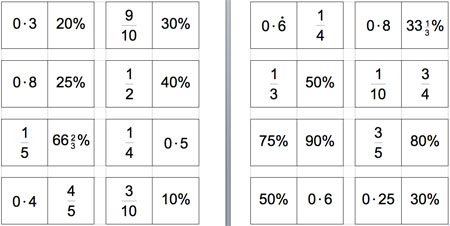Or search by topic
Number and algebra
Geometry and measure
Probability and statistics
Working mathematically
Advanced mathematics
For younger learners
Doughnut Percents
This is one of a series of problems designed to develop students' team working skills. Other tasks in the series can be found by going to this article.
Doughnut Percents - printable dominoes
Doughnut Percents - printable rule cards
Doughnut Percents - printable hint cards

What are you aiming to do?
Every member of the team must end up with a set of four dominoes which join together to form a "doughnut" where touching ends have equal value. For example:

The task is only successfully completed when everyone on the team has completed their domino doughnut.
You will need to work in a team of four. If you have a fifth person available - use them as an observer (see guidance below).
Players pass dominoes to other team members in order to help one another complete their doughnut.
- Each member of the team starts with four dominoes in front of them.
- The dominoes in front of each person should be visible to everyone.
- Team members can only give dominoes; they cannot take dominoes from someone else.
- Each team member must have at least two dominoes in front of them at all times.
- No one can talk or give non-verbal signals to other members of the team.
Use an observer to check that the team obeys the rules and to keep a record of when members of the team help someone else (rather than, for example, when they just pass a piece on without looking at what the other person or team actually needs).
Observers can place one of the hint cards in the middle, if after a period of five minutes the team is not making any progress.



